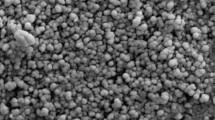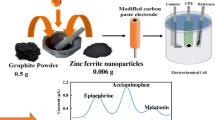Abstract
A nanocomposite of iron(III) oxide and tin(IV) oxide, Fe2O3(0.5)/SnO2(0.5), was prepared by a solid-phase reaction in an alkaline medium. The nanocomposite was characterized by X-ray diffraction, field-emission scanning electron microscopy, and Fourier transform infrared spectroscopy. A fast-response sensor was prepared by electrochemical deposition of the nanocomposite on a glassy carbon electrode. The prepared sensor has an excellent electrocatalytic activity toward the oxidation of epinephrine (EP), acetaminophen (AC), and tryptophan (Trp), therefore, this sensor was used for simultaneous determination of the above drugs. The separation of the oxidation peak potentials for EP–AC and AC–Trp were about 160 and 280 mV, respectively. The calibration curves obtained for EP, AC, and Trp were in the ranges of 0.6–270.0 µmol L−1, 4.5–876.0 µmol L−1, and 0.6–70.0 µmol L−1, respectively. The detection limits (S/N = 3) were 0.07, 0.2, and 0.1 µmol L−1 for EP, AC, and Trp, respectively. Finally, the sensor was used for determination of EP, AC, and Trp in pharmaceutical and biological samples.
Graphical Abstract









Similar content being viewed by others
References
Taylor RJ, Humffray AA (1973) Electrochemical studies on glassy carbon electrodes: I. Electron transfer kinetics. J Electroanal Chem 42:347–354
Blaedel WJ, Jenkins RA (1975) Electrochemical oxidation of reduced nicotinamide adenine dinucleotide. Anal Chem 47:1337–1343
Engstrom RC (1982) Electrochemical pretreatment of glassy carbon electrodes. Anal Chem 54:2310–2314
Engstrom RC, Strasser VA (1984) Characterization of electrochemically pretreated glassy carbon electrodes. Anal Chem 56:136–141
Cabaniss GE, Diamantis AA, Murphy JWR, Linton RW, Meyer TJ (1985) Electrocatalysis of proton-coupled electron-transfer reactions at glassy carbon electrodes. J Am Chem Soc 107:1845–1853
Hu IF, Karweik DH, Kuwana J (1985) Activation and deactivation of glassy carbon electrodes. J Electroanal Chem 188:59–72
Yu L, Li L, Gao XM, Zhang Y, Meng FN, Wang TS, Xiao G, Chen YJ, Zhu CL (2012) Synthesis and H2S gas sensing properties of cage-like α-MoO3/ZnO composite. Sens Actuators B 171:679–685
Jinkawa T, Sakai G, Tamaki J, Miura N, Yamazoe N (2000) Relationship between ethanol gas sensitivity and surface catalytic property of tin oxide sensors modified with acidic or basic oxides. J Mol Catal A 155:193–200
Chu DW, Zeng YP, Jiang DL, Masuda Y (2009) In2O3–SnO2 nano-toasts and nanorods: precipitation preparation, formation mechanism, and gas sensitive properties. Sens Actuators B 137:630–636
Sharifi E, Salimi A, Shams E (2012) DNA/nickel oxide nanoparticles/osmium(III)-complex modified electrode toward selective oxidation of l-cysteine and simultaneous detection of l-cysteine and homocysteine. Bioelectrochemistry 86:9–21
Rafiee B, Fakhari AR (2013) Electrocatalytic oxidation and determination of insulin at nickel oxide nanoparticles-multiwalled carbon nanotube modified screen printed electrode. Biosens Bioelectron 46:130–135
Liu XH, Zhang J, Guo XZ, Wu SH, Wang SR (2010) Porous α-Fe2O3 decorated by Au nanoparticles and their enhanced sensor performance. Nanotechnology 21:095501
Chen J, Xu LN, Li WY (2005) α-Fe2O3 nanotubes in gas sensor and lithium-ion battery applications. Adv Mater 17:582–586
Wang YL, Jiang XC, Xia YN (2003) A solution-phase precursor route to polycrystalline SnO2 nanowires that can be used for gas sensing under ambient conditions. J Am Chem Soc 125:16176–16177
Zhang P, Guo ZP, Liu HK (2010) Submicron-sized cube-like α-Fe2O3 agglomerates as an anode material for Li-ion batteries. Electrochim Acta 55:8521–8526
Li LL, Chu Y, Liu Y, Dong LH (2007) Template-free synthesis and photocatalytic properties of novel Fe2O3 hollow spheres. J Phys Chem C 111:2123–2127
Vuong DD, Trung KQ, Hung NH, Hien NV, Chien ND (2014) Facile preparation of large-scale a-Fe2O3 nanorod/SnO2 nanorod composites and their LPG-sensing properties. J Alloys Compd 599:195–201
Xia H, Zhuang H, Zhang T, Xiao D (2008) Visible-light-activated nanocomposite photocatalyst of Fe2O3/SnO2. Mater Lett 62:1126–1128
Kotsikau D, Ivanovskaya M, Orlik D, Falasconi M (2004) Gas sensitive properties of thin and thick film sensors based on Fe2O3–SnO2 nanocomposites. Sens Actuators B 101:199–206
Huang L, Fan H (2012) Room-temperature solid state synthesis of ZnO/α-Fe2O3 hierarchical nanostructures and their enhanced gas-sensing properties. Sens Actuators B 171–172:1257–1263
Li P, Fan H, Cai Y (2013) In2O3/SnO2 heterojunction microstructures: Facile room temperature solid-state synthesis and enhanced Cl2 sensing performance. Sens Actuators, B 185:110–116
Ensafi AA, Taei M, Khayamian T (2009) A differential pulse voltammetric method for simultaneous determination of ascorbic acid, dopamine, and uric acid using poly (3-(5-chloro-2-hydroxyphenylazo)-4,5-dihydroxynaphthalene-2,7-disulfonic acid) film modified glassy carbon electrode. J Electroanal Chem 633:212–220
Bessems JGM, Vermeulen NPE (2001) Paracetamol (acetaminophen)-induced toxicity: molecular and biochemical mechanisms, analogues and protective approaches. Crit Rev Toxicol 31:55–138
Olaleye MT, Rocha BTJ (2008) Acetaminophen-induced liver damage in mice:effects of some medicinal plants on the oxidative defence system. Exp Toxicol Pathol 59:319–327
Roberts JC, Phaneuf HL, Szakacs JG, Zera RT, Lamb JG, Franklin MR (1998) Differential chemoprotection against acetaminophen-induced hepatotoxicity by latentiated l-cysteines. Chem Res Toxicol 11:1274–1282
Mazer M, Perrone J (2008) Acetaminophen-induced nephrotoxicity: pathophysiology, clinical manifestations, and management. J Med Toxicol 4:2–6
Takikawa O (2005) Biochemical and medical aspects of the indoleamine 2,3-dioxygenase-initiated l-tryptophan metabolism. Biochem Biophys Res Commun 338:12–19
Carlsson A, Lindqvist M (1978) Dependence of 5-HT and catecholamine synthesis on concentrations of precursor amino-acids in rat brain. Naunyn Schmiedeberg’s Arch Pharmacol 303:157–164
Prabhu P, Babu RS, Narayanan SS (2011) Electrocatalytic oxidation of l-tryptophan using copper hexacyanoferrate film modified gold nanoparticle graphite–wax electrode. Colloids Surf B 87:103–108
Kochen W, Steinhart H (1994) l-Tryptophan: current prospects in medicine and drug safety. de-Gruyter, Berlin
Nasirizadeh N, Shekari Z, Zare HR, Shishehborec MR, Fakhari AR, Ahmar H (2013) Electrosynthesis of an imidazole derivative and its application as a bifunctional electrocatalyst for simultaneous determination of ascorbic acid, adrenaline, acetaminophen, and tryptophan at a multi-wall carbon nanotubes modified electrode surface. Biosens Bioelectron 41:608–614
Devadas B, Rajkumar M, Chen SM (2013) Electropolymerization of curcumin on glassy carbon electrode and its electrocatalytic application for the voltammetric determination of epinephrine and p-acetoaminophenol. Colloids Surf B 116:674–680
Tavana T, Khalilzadeh MA, Karimi-Maleh H, Ensafi AA, Beitollahi H, Zareyee D (2012) Sensitive voltammetric determination of epinephrine in the presence of acetaminophen at a novel ionic liquid modified carbon nanotubes paste electrode. J Mol Liq 168:69–74
Mazloum-Ardakani M, Beitollahi H, Sheikh Mohseni MA, Benvidi A, Naeimi H, Nejati-Barzoki M, Taghavinia N (2010) Simultaneous determination of epinephrine and acetaminophen concentrations using a novel carbon paste electrode prepared with 2,2′-[1,2 butanediylbis (nitriloethylidyne)]-bis-hydroquinone and TiO2 nanoparticles. Colloids Surf B 76:82–87
Mazloum-Ardakani M, Dehghani-Firouzabadi A, Rajabzade N, Sheikh-Mohseni MA, Benvidi A, Abdollahi-Alibeik M (2013) MCM/ZrO2 nanoparticles modified electrode for simultaneous and selective voltammetric determination of epinephrine and acetaminophenm. J Iran Chem Soc 10:1–5
Raoof JB, Chekin F, Ojani R, Barari S, Anbia M, Mandegarzad S (2012) Synthesis and characterization of ordered mesoporous carbon as electrocatalyst for simultaneous determination of epinephrine and acetaminophen. J Solid State Electrochem 16:3753–3760
Ensafi AA, Karimi-Maleh H, Mallakpour S (2012) Simultaneous determination of ascorbic acid, acetaminophen, and tryptophan by square wave voltammetry using N-(3,4-dihydroxyphenethyl)-3,5-dinitrobenzamide-modified carbon nanotubes paste electrode. Electroanalysis 24:666–667
Firooz AA, Mahjoub AR, Khodadadi AA (2009) Effects of flower-like, sheet-like and granular SnO2 nanostructures prepared by solid-state reactions on CO sensing. Mater Chem Phys 115:196–199
Galus Z (1976) Fundumentals of electrochemical analysis. Ellis Horwood, New York
Bulatova AV, Petrova AV, Vishnikin AB, Moskvin AL, Moskvin LN (2012) Stepwise injection spectrophotometric determination of epinephrine. Talanta 96:62–67
Safavi A, Moradlou O (2004) Simultaneous kinetic determination of paracetamol and p-aminophenol by using H-point standard addition method. Anal Lett 37:2337–2349
Acknowledgments
The authors gratefully acknowledge support of this work by the Research Council of Payame Noor University and the Center of Excellence in Sensor and Green Chemistry.
Author information
Authors and Affiliations
Corresponding author
Electronic supplementary material
Below is the link to the electronic supplementary material.
Rights and permissions
About this article
Cite this article
Taei, M., Shavakhi, M., Hadadzadeh, H. et al. Simultaneous determination of epinephrine, acetaminophen, and tryptophan using Fe2O3(0.5)/SnO2(0.5) nanocomposite sensor. J Appl Electrochem 45, 185–195 (2015). https://doi.org/10.1007/s10800-014-0756-1
Received:
Accepted:
Published:
Issue Date:
DOI: https://doi.org/10.1007/s10800-014-0756-1




